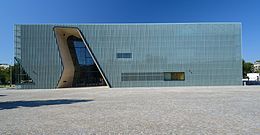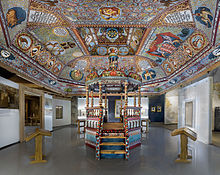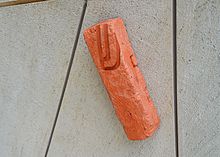Museum of History of Polish Jews
| Muzeum Historii Żydów Polskich | |

The museum building
|
|
| Established | 2005 (opened April 2013) |
|---|---|
| Location | Warsaw, Poland |
| Coordinates | 52°14′58″N 20°59′34″E / 52.24944°N 20.99278°E |
| Type | Historical, cultural |
| Collection size | History and culture of Polish Jews |
| Visitors | expected 450,000 |
| Director | Dariusz Stola |
| Curator | Barbara Kirshenblatt-Gimblett |
| Website | Museum official website |
| Selected features | |
|---|---|

Hebrew and Latin letters of the word Polin
|
|

Main hall
|
|

Gwoździec synagogue roof reconstruction
|
|

Reconstructed vault and bimah in the Museum of the History of Polish Jews
|
|

"On the Jewish Street" gallery with entrances to exhibition halls
|
|

Traditional Mezuzah at the entrance
|
|

Facing the Museum, is the Monument to the Ghetto Heroes
|
POLIN Museum of the History of Polish Jews (Polish: Muzeum Historii Żydów Polskich) is a museum on the site of the former Warsaw Ghetto. The Hebrew word Polin in the museum's name means, in English, either "Poland" or "rest here" and is related to a legend on the arrival of the first Jews in Poland. The cornerstone was laid in 2007, and the museum was first opened on April 19, 2013. The museum's Core Exhibition opened in October 2014. The museum features a multimedia narrative exhibition about the living Jewish community that flourished in Poland for a thousand years up to the Holocaust. The building, a postmodern structure in glass, copper, and concrete, was designed by Finnish architects Rainer Mahlamäki and Ilmari Lahdelma.
The idea for creating a major new museum in Warsaw dedicated to the history of Polish Jews was initiated in 1995 by the Association of the Jewish Historical Institute of Poland. In the same year, the Warsaw City Council allocated the land for this purpose in Muranów, Warsaw’s prewar Jewish quarter and site of the former Warsaw Ghetto, facing the Monument to the Warsaw Ghetto Heroes. In 2005, the Association of the Jewish Historical Institute of Poland established a private-public partnership with the Polish Ministry of Culture and National Heritage and the City of Warsaw. The Museum's first director was Jerzy Halbersztadt. In September 2006, a specially designed tent called Ohel (the Hebrew word for tent) was erected for exhibitions and events at site of the museum's future location.
An international architectural competition to design the building was launched in 2005, supported by a grant from the Ministry of Culture and National Heritage. On June 30, 2005, the winner was announced by the jury as the team of two Finnish architects, Rainer Mahlamäki and Ilmari Lahdelma. On June 30, 2009, construction of the building was officially inaugurated. The project was completed in 33 months at a cost of 150 million zloty allocated by the Ministry and the City, with a total cost of 320 million zloty.
...
Wikipedia
